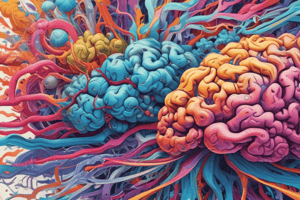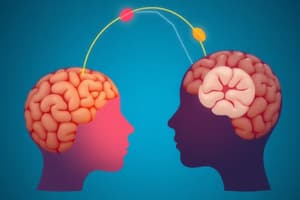Podcast
Questions and Answers
What changes in cognitive performance are typically observed during adolescence?
What changes in cognitive performance are typically observed during adolescence?
- Enhanced metacognitive skills (correct)
- Reduced problem-solving abilities
- Increased auditory processing speed
- Decreased visual memory capacity
What factor contributes to the variability in defining the onset of adulthood?
What factor contributes to the variability in defining the onset of adulthood?
- Age at which friendships stabilize
- Variability in parental guidance
- Cultural expectations around family structures
- Differing definitions of adulthood across societies (correct)
How does the total cerebral volume change during adolescence?
How does the total cerebral volume change during adolescence?
- It decreases significantly after age 14
- It remains consistent throughout adolescence
- It peaks prior to adolescence in both genders
- It peaks during different ages for males and females (correct)
Which cognitive skill tends to be more developed in girls than in boys during the early teenage years?
Which cognitive skill tends to be more developed in girls than in boys during the early teenage years?
What is the relationship between practice and the development of cognitive skills in boys and girls?
What is the relationship between practice and the development of cognitive skills in boys and girls?
What does memory organisation analogy in adolescence resemble?
What does memory organisation analogy in adolescence resemble?
Which of the following types of memory is linked to developmental changes during adolescence?
Which of the following types of memory is linked to developmental changes during adolescence?
What aspect of adolescent development can result in increased cognitive resources?
What aspect of adolescent development can result in increased cognitive resources?
What does make-believe play among young children primarily demonstrate?
What does make-believe play among young children primarily demonstrate?
How do young children adapt their motor skills during pretend play?
How do young children adapt their motor skills during pretend play?
What is one key distinction children recognize during pretend play?
What is one key distinction children recognize during pretend play?
What significant cognitive development occurs during adolescence regarding hypothetical thinking?
What significant cognitive development occurs during adolescence regarding hypothetical thinking?
In what way does the transition from childhood to adolescence affect hypothetical thinking?
In what way does the transition from childhood to adolescence affect hypothetical thinking?
According to the study by Guttentag and Ferrell (2008), what differentiates the responses of teenagers and adults from those of children?
According to the study by Guttentag and Ferrell (2008), what differentiates the responses of teenagers and adults from those of children?
What role does real-world knowledge play in the context of hypothetical thinking during pretend play?
What role does real-world knowledge play in the context of hypothetical thinking during pretend play?
What can be concluded about the relationship between hypothetical thinking and pretend play in children?
What can be concluded about the relationship between hypothetical thinking and pretend play in children?
What is primarily responsible for the communication between neurons in the brain?
What is primarily responsible for the communication between neurons in the brain?
Which process is associated with enhancing the efficiency of signal transmission in the brain?
Which process is associated with enhancing the efficiency of signal transmission in the brain?
During which developmental period is a marked increase in white matter observed?
During which developmental period is a marked increase in white matter observed?
What is the primary function of the Corpus Callosum?
What is the primary function of the Corpus Callosum?
What imaging technique is specifically designed to visualize the microstructures within the brain?
What imaging technique is specifically designed to visualize the microstructures within the brain?
Which of the following cognitive abilities typically emerges during Piaget's formal operations stage?
Which of the following cognitive abilities typically emerges during Piaget's formal operations stage?
Anisotropic white matter is characterized by which of the following?
Anisotropic white matter is characterized by which of the following?
How does increased white matter correlate with cognitive functionality during adolescence?
How does increased white matter correlate with cognitive functionality during adolescence?
What is a goal of the concrete operational stage in Piaget's theory?
What is a goal of the concrete operational stage in Piaget's theory?
What does hypothetical thinking during adolescence allow individuals to do?
What does hypothetical thinking during adolescence allow individuals to do?
What is the primary purpose of studying behavioral changes alongside structural brain changes?
What is the primary purpose of studying behavioral changes alongside structural brain changes?
What does it mean if white matter is described as more anisotropic?
What does it mean if white matter is described as more anisotropic?
At what age range does marked development of the Corpus Callosum occur?
At what age range does marked development of the Corpus Callosum occur?
Flashcards
Adolescence Brain Changes
Adolescence Brain Changes
The brain undergoes significant changes during adolescence, including alterations in size, structure, and function, from puberty through adulthood.
Adolescent Cognitive Changes
Adolescent Cognitive Changes
Changes observed in cognitive processes, including memory, attention, and decision-making during adolescence.
Working Memory Development
Working Memory Development
Working memory abilities improve significantly during childhood and adolescence, becoming more efficient in holding and manipulating information.
Brain Size Differences (M+F)
Brain Size Differences (M+F)
Signup and view all the flashcards
Memory Automation
Memory Automation
Signup and view all the flashcards
Memory Organization
Memory Organization
Signup and view all the flashcards
Selective Attention Training
Selective Attention Training
Signup and view all the flashcards
Brain Measurement Variability
Brain Measurement Variability
Signup and view all the flashcards
Counter-Reality Scenario
Counter-Reality Scenario
Signup and view all the flashcards
Consequences of Imagined Scenarios
Consequences of Imagined Scenarios
Signup and view all the flashcards
Transcience of Imagined States
Transcience of Imagined States
Signup and view all the flashcards
Concrete Materials in Pretend Play
Concrete Materials in Pretend Play
Signup and view all the flashcards
Mental Workspace in Adolescent Thinking
Mental Workspace in Adolescent Thinking
Signup and view all the flashcards
Multiple Scenarios in Adolescent Thinking
Multiple Scenarios in Adolescent Thinking
Signup and view all the flashcards
Uni-directionality in Child Pretend Play
Uni-directionality in Child Pretend Play
Signup and view all the flashcards
Hypothetical Thinking in Adolescence
Hypothetical Thinking in Adolescence
Signup and view all the flashcards
White Matter: What is it?
White Matter: What is it?
Signup and view all the flashcards
Myelin: Why is it important?
Myelin: Why is it important?
Signup and view all the flashcards
Learning and White Matter: What's the connection?
Learning and White Matter: What's the connection?
Signup and view all the flashcards
Corpus Callosum: What is it?
Corpus Callosum: What is it?
Signup and view all the flashcards
Adolescence and White Matter: How are they related?
Adolescence and White Matter: How are they related?
Signup and view all the flashcards
Diffusion Tensor Imaging (DTI): What does it do?
Diffusion Tensor Imaging (DTI): What does it do?
Signup and view all the flashcards
Anisotropy: What does it mean?
Anisotropy: What does it mean?
Signup and view all the flashcards
Hypothetical Thinking: What is it?
Hypothetical Thinking: What is it?
Signup and view all the flashcards
Piaget's Formal Operational Stage: What is it?
Piaget's Formal Operational Stage: What is it?
Signup and view all the flashcards
How Does Hypothetical Thinking Evolve?
How Does Hypothetical Thinking Evolve?
Signup and view all the flashcards
Adolescence and Cognitive Abilities: What's the link?
Adolescence and Cognitive Abilities: What's the link?
Signup and view all the flashcards
Benefits of Increased Cognitive Abilities: What are they?
Benefits of Increased Cognitive Abilities: What are they?
Signup and view all the flashcards
White Matter Growth: What is it good for?
White Matter Growth: What is it good for?
Signup and view all the flashcards
Brain Development: Why does it matter?
Brain Development: Why does it matter?
Signup and view all the flashcards
Study Notes
Adolescence: Neuro/Cognitive Changes
- Adolescence spans puberty to adulthood, a period marked by biological, cognitive, and social changes.
- Defining adolescence is complex due to the variable onset of puberty and varying ages of adulthood.
Brain Structure and Development
- Brain size (total cerebral volume) peaks slightly before adolescence for females and during adolescence for males. However, these apparent differences are not significant once corrected for body size.
- Key changes include increases in white matter, particularly during adolescence.
- White matter, composed of myelinated axons, facilitates communication between brain regions, leading to more efficient and faster processing.
- Diffusion Tensor Imaging (DTI), a variation of MRI, can examine the detailed structure of white matter fibers and measure anisotropy, which reflects the efficiency of neuronal processing.
White Matter and Cognitive Functioning
- Increased white matter correlates with improved cognitive function, evident in memory, language, and higher IQ scores.
- This is because a more substantial network of myelinated axons allows for more effective transmission and processing of information.
- The corpus callosum, a crucial bundle of white matter fibers connecting the brain hemispheres, develops significantly throughout childhood and into adolescence, likely contributing to better cognitive performance.
Hypothetical Thinking and Piaget's Stages
- Piaget’s theory proposes a progression through stages of cognitive development, including sensorimotor, preoperational, concrete operational, and formal operational stages.
- Formal operational thought, characteristic of adolescence and adulthood, involves the ability to engage in hypothetical thinking, consider possibilities beyond current reality, and manipulate abstract concepts.
- Hypothetical thinking allows individuals to imagine alternative scenarios and consider potential consequences, leading to a more nuanced understanding of the world and self.
Evidence for Hypothetical Thinking Development
- While pretend play exhibits some imagination, true hypothetical thinking seems to emerge during adolescence, marked by abilities to consider multiple scenarios and consider the real versus imagined.
- Studies like Guttentag and Ferrell (2008), showed that adolescents, unlike younger children, could imagine avoiding regret by considering a hypothetical scenario (e.g., choosing the right box).
Implications of Adolescent Cognitive Development
- The enhancements in white matter and hypothetical thinking during adolescence equip individuals with the cognitive tools necessary for transitioning into adulthood, including forming self-identities and navigating complex social situations.
Studying That Suits You
Use AI to generate personalized quizzes and flashcards to suit your learning preferences.




